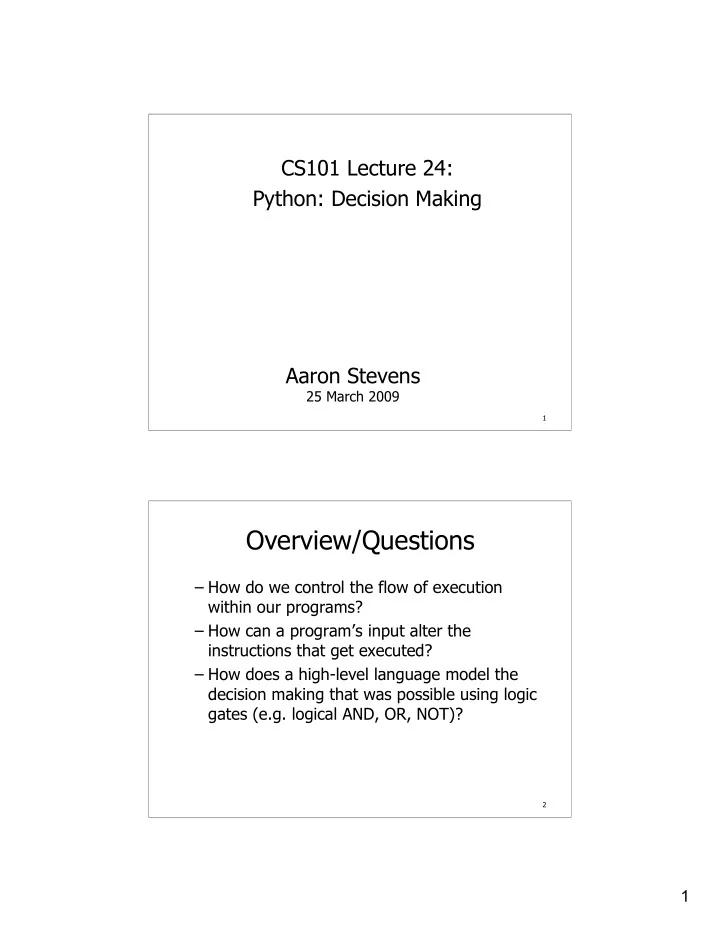

CS101 Lecture 24: Python: Decision Making Aaron Stevens 25 March 2009 1 Overview/Questions – How do we control the flow of execution within our programs? – How can a program’s input alter the instructions that get executed? – How does a high-level language model the decision making that was possible using logic gates (e.g. logical AND, OR, NOT)? 2 1
Decisions: what’s the point? Previously, all of our programming code has always been executed – at least once. We’ve used some techniques to modify this: – Definite loops execute a fixed number of times. – Functions allow us to execute the same code an arbitrary number of times. 3 Flow of Control Sequential Execution Each instruction is executed in order they are written (after the previous one, before the next on). Functions Functions modify the flow of control by delegating some work to be done by a separate functions, library, etc. 4 2
Flow of Control Selection Some statements are executed while others are not. Repetition Statements can be repeated some fixed number of time, or else can be repeated until some event signals they should not be repeated any more. 5 Logical Expressions Expression A programming statement which achieves a value. Python example: 5 - 3 Logical Expression Programming statement which achieves a Boolean logical result (True or False). 6 3
Python Logical Operators Boolean constants Python provides 2 boolean constants: False – logical value, numeric value of 0 True – logical value, numeric value of NOT 0 7 Python Equality Operators Equality == True if and only if both operands have the same value. Example: 5 == 3 Inequality != True if and only if the operands do not have the same value. Example: 5 != 3 8 4
Python Relational Operators Less than < True if and only if LHS operand has a numeric value less than RHS operand. Example: 5 < 3 Greater than > True if and only if LHS operand has a numeric value more than RHS operand. Example: 5 > 3 9 Python Relational Operators Less than or equal <= True if LHS operand has a numeric value less than or equal to RHS operand. Example: 5 <= 3 Greater than or equal >= True if LHS operand has a numeric value more or equal to RHS operand. Example: 5 >= 3 10 5
Python Logical Operators Logical AND and True if and only if both operands are True. Example: (3 < 5) and (5 >= 4) Logical OR or True if either operands is True. Example: (3 < 5) or (5 < 4) 11 Python Logical Operators Logical Negation not True if operand has a value of False. Example: not 0, not True 12 6
if statement if statement A structure which evaluates a logical expression, and controls a block of statements. 13 Controlled Block A set of statements which are “controlled” by a control statement. A controlled block must be indented: 14 7
else statement else statement A control statement which is subordinate to a an if statement. 15 Chained/nested logic statements 16 8
elif statement elif statement A control statement which is subordinate to a an if statement, but checks a secondary condition. An elif is only evaluated if the first if evaluated to false. 17 Completed Example 18 9
Variable Scope Scope refers to the places in a program where a variable name can be referenced. Any variables introduced in a control structure are local to that structure – not accessible outside the block. Variables from outside the control structure are still accessible. Variables needed after a control-structure must be declared before the structure begins. 19 Nested logic All control statements can be nested inside other control statements. Thus, some logical tests depend on the outcome of previous logical tests before even being evaluated. Example: what clothing to wear based on temperature, conditions. – 78 degrees and sun – 78 degrees and rain – 30 degrees and sun – 30 degrees and sleet 20 10
Nested logic 21 Take-Away Points – Flow of control, decision making – Logical expressions – if / elif / else statements – Variable scope – Nested logic 22 11
Student To Dos – QUIZ 4 is on FRIDAY 3/28 Covers material in lectures (16-22) Flash concepts, motion tweens, images, audio Programming languages, python introduction Elements of python programs, computing with numbers – Reading: How to Think Like A Computer Scientist: Learning with Python Available online at: http://openbookproject.net//thinkCSpy/ Ch04 (Wednesday/Friday) 23 12
Recommend
More recommend